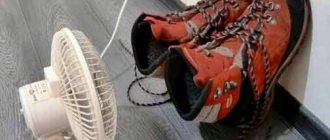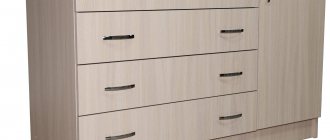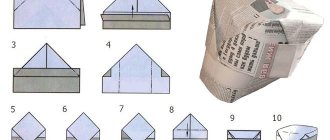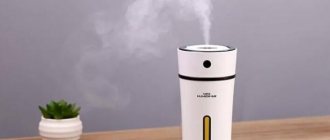It is not for nothing that a lot of attention is paid to maintaining air humidity in a living room, as it affects human health. But what's the point of paying for an expensive device if you can assemble a humidifier yourself? It will not be inferior in performance to its factory counterpart.
There are several types of devices that can be made literally “on the knee”. In this article, we examined the principles of operation of household humidifiers and how to make them yourself.
Popular and effective methods of creating conditions for better evaporation associated with heating water and exposing it to air flow are considered. We will also show you how to assemble a homemade device based on an ultrasonic nebulizer.
Using a humidifier in winter
Before you start building a humidifier, you need to clearly understand its purpose. For example, it is able to maintain the humidity of room air at a normal level during the winter season.
The need for this is explained by the fact that central heating radiators that cannot be switched off greatly dry out the room atmosphere. Breathing dry air is quite harmful to health.
This may cause
- Respiratory diseases;
- Various types of allergic reactions;
- Other problematic phenomena.
Why humidify the air?
[turbobutton]
It’s unlikely that anyone thinks about how much humidity there is in the air in the house. This is because people underestimate the importance of this indicator: in deserts, humidity never exceeds 25% and only rare animals and insects live there, adapted to life in extreme conditions. For humans, the optimal air humidity is 50-60%, but fluctuations in the range of 40-70% are allowed.
Why is dry air dangerous? When humidity decreases to 30%, the following occurs:
- Drying of the mucous membrane of the eyeballs , which provokes the onset of the inflammatory process - conjunctivitis. The eyes turn red, a cutting pain appears, and the body produces more tear fluid to moisturize and cleanse the membrane. Random lacrimation begins;
- Drying of the nasal mucosa is the first defense against pathogens on the way inside the body. Viruses, microscopic fungi and bacteria hover in the air mass. By inhaling it, microorganisms enter the nose. If its walls are sufficiently moistened, then all the microflora settles on the mucus produced by the shell, which comes out in the form of snot. If the nasal mucosa is dry, then there are no obstacles for microorganisms to penetrate inside. The risk of contracting an infection increases sharply;
- Drying of the mucous membranes of the mouth and throat leads to a decrease in resistance to pathogenic microflora and the development of inflammatory diseases. The gums swell, become loose and bleeding - gingivitis begins. The throat is sore, it often hurts, the tonsils become inflamed;
- Increased dust content in the air . Dust is a breeding ground for dust mites. The more dust, the more mites. Together with dust, they can cause the onset of bronchial asthma or allergies.
All these are powerful arguments that lead to the decision to buy or build a homemade air humidifier. This is especially true in winter, when air humidity due to a radiator heating system can drop to 20%. It is dangerous even for an adult to be in such conditions, but first of all you need to take care of protecting the respiratory organs of children by installing humidifiers in children's rooms.
Caring for children and adults
The need for an air humidifier is especially great in an apartment where there is a newborn or small child. His respiratory system is still too weak and therefore needs to constantly maintain favorable conditions for it. It is a stable working humidifier that can create an optimal atmosphere for the lungs and bronchi of such a child.
For adults, the presence of a humidifier is also a factor that significantly facilitates the breathing process. This device will raise the humidity level in a room or kitchen to 50-60%, which is considered an acceptable indicator for maintaining good health.
Dry air problem
Humidity, temperature and oxygen concentration are the most important parameters of the microclimate of a living space, on which a person’s well-being depends. In winter, indoors, the water content in the air decreases. This is an easily explained physical process, the consequences of which can be eliminated with fairly simple actions.
Causes of lack of moisture
In a climate of moderate humidity, characteristic of most regions of Russia, dryness in the room occurs during the cold season. It is caused by a simple physical phenomenon: the volume of water required for one hundred percent humidity decreases as the air temperature decreases.
Thus, cold air coming from the street carries very little water into the room. And the warm flow emanating through the ventilation system can carry away several times more. This leads to imbalance.
The maximum possible volume of water contained at “-20” and “+25” degrees differs by almost 30 times. This is the main reason for dryness in the apartment when frosty air enters.
Partially, the lack of moisture is compensated inside the apartment due to the following phenomena:
- availability of open water sources;
- evaporation of moisture from washed dishes and laundry;
- breathing of humans and domestic animals;
- watering flowers, wet cleaning.
Often this cannot completely restore the humidity to the desired values. In regulatory documents such as SNiP 41-01-2003 “Heating, ventilation and air conditioning” and SanPiN 2.1.2.2645-10 “Sanitary and epidemiological requirements for living conditions in residential buildings and premises”, optimal relative humidity indicators are set in the range of 30-45 %.
In this regard, residents are making attempts to achieve standard indicators through some kind of adaptations. There are many household humidifiers on the market now.
However, high-quality devices are not cheap and require maintenance. Therefore, many are inclined to alternative methods of saturating the air with water or to making homemade devices.
Most modern household humidifiers work on the principle of creating “cold” steam as a result of ultrasonic spraying
So, the main reason for dry indoor air is the flow of air with a very low moisture content. However, there are theories that some devices (heating radiators, oil heaters, convectors, incandescent lamps) “dry” the air.
This myth-making is supported by heating equipment manufacturers and “advanced” managers to increase sales of expensive appliances.
There can be no physical basis for the disappearance of water molecules in a living space if there is no portable hadron collider or an artifact of an alien high-tech civilization.
The chemical reaction of water binding due to intramolecular interactions (hydration) occurs in such an insignificant amount that it can be neglected. Therefore, you can only “save” on ventilation, but this will lead to an imbalance in the oxygen balance. There is only one thing left - compensation for moisture loss.
The simplest methods of increasing air humidity
The problem of dry air has been known for a long time, so there is experience in increasing humidity in the following elementary ways:
- Hanging wet fabric on ropes. Evaporation occurs intensely, but the material dries quickly. In addition, laundry takes up a lot of space.
- Installation of filled containers with a large evaporation area. These are usually basins, although an aquarium can also be used if the top glass is removed.
Having a lot of plants in your home also increases humidity. They have to be watered frequently, which causes water to enter the air through the leaves (transpiration).
Such a flower evaporates about 200 grams of water per day, that is, it is capable of releasing moisture for 30 cubic meters of room air to saturate it to 35 percent humidity at a temperature of “+22” degrees
Wiping the floor and interior items with a damp cloth gives an effect similar to hanging a wet cloth: the air is quickly saturated. Therefore, you should not neglect this type of cleaning, especially in winter.
Cost-effective device
An important feature of such a device is the fact that it does not require any energy resources. In this case, only water will be consumed.
You can assemble such a unit in just a few minutes, but it will provide the necessary effect at the same level as a store-bought humidifier.
Place containers of water around the apartment
You can do without boiling. Simply fill vases, bottles and other containers with water and place them near heat sources. If you add stones and flowers, you will get a beautiful composition - guests, most likely, will not even realize that these are not decorative elements, but homemade humidifiers. Just remember to periodically wash the containers and change the water.
furnitureteams.com
domo.plius.lt
mynohar.com
Step-by-step instruction
The step-by-step sequence of assembling such a device is as follows:
- It is necessary to cut an opening measuring 10x5 cm in the bottle. The hole should be located in the middle part of the bottle, it should be oriented along the vertical axis.
- Next, the bottle is hung on the heating radiator so that the slot “looks” at the pipe extending from the battery. Thick rope or strips cut from fabric will help with this. To ensure that the resulting structure does not tilt or rotate, the area of contact between the bottle and the fabric must be taped with tape.
- At the next stage, gauze is taken and folded into several layers. The result should be a strip about a meter long and about 10 cm wide.
- The middle section of gauze in the form of a long loop is lowered into the slot of the bottle. The rest of it is screwed onto the pipe. If it is necessary to ensure accelerated hydration, take several gauze strips at once.
- After all preparations are completed, water is poured into the humidifier. From this moment he begins to act - slowly but surely.
From a plastic container
Humidification of the air in the apartment is necessary. The health of all living people in the house depends on this. This is especially important for allergy sufferers.
You can buy air humidifiers, or you can make your own using improvised means. The second option is more economical and more enjoyable to admire your own invention.
This method is more complicated than using a plastic bottle humidifier, but it is also more effective.
Procedure:
- Take a mesh box, which should be slightly smaller than a regular plastic one. Attach a fishing line to the top and pull it tight.
- Hang the cut bandages on the fishing line. The gauze should reach the bottom and dangle there freely.
- The mesh box is placed in a large container into which water is poured.
- Then cut a hole in the lid of a large container the size of the fan, which is attached there using a glue gun or double-sided tape.
- All that remains is to turn on the fan.
This design is very quiet. The fan spins, thereby humidifying the air. Sometimes water needs to be added.
This option for humidifying indoor air is effective and, most importantly, economical.
Alternative battery humidifier design
There is another modification of the battery humidifier. It consists of vessels with water, which are fixed to the battery body with a rope.
The fastening must be so strong that containers filled with water do not break off, warp or fall to the floor.
- Long flower vases of small mass can be used as working vessels.
- It is desirable that they have a rectangular or cylindrical cross-section, which will allow them to come into contact with the vertical of the battery along its entire length.
If the vases that heat water and evaporate moisture are attractively designed, then in addition to the main function they will perform an auxiliary function, decorating the room with an unexpected technical installation.
From the fan
A fan with an air humidifier is also an economical option for effective air conditioning.
It has many advantages, including:
- ease of use;
- the ability to be carried throughout the apartment;
- low energy consumption;
- can be used not only as a humidifier, but also as an aroma lamp.
It is not difficult to humidify the air in an apartment if a man understands such technologies.
How to make a humidifier with your own hands from a fan:
- Wet the dense material with water, squeeze it out so that the liquid does not flow onto the floor. Hang the fabric at a height higher than the height of the floor fan. Install the latter behind the material and turn it on. The fabric will have to be constantly wetted, which is not very convenient.
- For the second option, you will need a cooler, old disks, a container with a capacity of 6 liters and scraps of plastic measuring 5 by 5 cm, a glue gun, a motor from a children's toy and a gear. How to make a home humidifier: plastic parts are needed to seal the holes on the disks, then take a tube and place the disks on it, securing them together with a glue gun. Next, you need to make holes in the container and insert a tube with disks into them. A gear is attached to one side, and the other is secured with washers. All that remains is to install the electric motor from the toy and connect it to the gear. The production of a homemade air humidifier is completed by installing the cooler in the lid of the container and connecting it to the network. The discs in the container are filled with water, but not completely.
That's all. If you follow the correct sequence for making a homemade fan, everything will work out.
The second version of the humidifier is more effective.
Simplified battery humidifier
Sometimes it is not possible to find any vases that match the geometric parameters and are beautifully painted. In this case, it makes sense to simplify this idea extremely.
It is enough to place an iron bowl of water on the battery. It will heat up well and thanks to this intensively saturate the surrounding air with water vapor.
The simplest ways to increase indoor humidity
Ventilation
Try to ventilate the room several times a day. Why breathe stale, stuffy air? In the morning, as soon as you get out of bed, open the window and go about your morning routine. The air from the street will fill your home with humidity and freshness.
Open a window when exercising or cleaning. Be sure to ventilate well before going to bed. And it’s easier to breathe, and your sleep will be deeper.
Many people believe that frosty air is already too dry and therefore will not be beneficial. When it enters the room, it mixes with warm water, creates condensation and provides sufficient humidity.
Wet cleaning
Cleanliness is the key to health! Who doesn't know this? Regular wet cleaning will only benefit both the apartment and its inhabitants.
Wash the floor, wipe off the dust with a damp cloth, and spray curtains and curtains with a spray bottle. And always with the window open - you won’t feel hot from physical work, and the stagnant air will disappear.
After cleaning, sit in a chair and take a deep breath. Do you feel the freshness and pleasant smell of dampness? Wet and clean!
Water tanks
Sometimes, in severe frosts, central heating radiators simply fry mercilessly. Of course, the house is warm, but at the same time unbearably dry. And now the grandfather began to cough, and the child began to sniffle. Opening the window is not an option; the frost will quickly freeze the room.
Take a basin or wide pan of water and place it under the heating system. Fasten a wide bandage or gauze with one end to the battery, and lower the other into water. The wider the fabric, the greater the volume of evaporation. Who's stopping you from hanging entire garlands of gauze?
If you don’t want to bother with basins and clutter up your apartment with them, use your imagination. Take out transparent vases and crystal from the sideboard, fill them with water and decorations - pebbles, seaweed, flowers. Beautiful compositions will fit into the interior and be beneficial. The main thing is not to forget to change the water with fresh water from time to time and wash the containers well.
Damp cloth on batteries
Wet a large terry towel and place it on the hot radiator. You will immediately feel how the air is humidified by evaporation from a large surface. The big disadvantage is that you will constantly have to run to the bathroom to wet a dry towel. But you will lose extra calories!
After washing, some of the laundry can be dried on the central heating radiators. Here you get double benefits - quick drying and good moisture. You need to look for benefits in everything!
Ventilation
If ventilation is a daily habit, then you can forget about problems with the microclimate. After all, the air becomes not only moisturized, but also fresh. In this case, the atmosphere inside the house will be directly influenced by the indicators outside. Therefore, the best effect can be achieved after rain, when the air outside is as humidified as possible. However, you should not keep the window open all day.
Especially in winter, when the temperature outside is low. It is enough to ventilate for 10-15 minutes. And do this 1-3 times a day. During cold months, you should not be near an open window - drafts and cold can lead to the occurrence of acute respiratory infections. For the same reason, it is best to ventilate when there are no children or pets nearby.
Pros:
- does not require much effort or time;
- accessibility;
- the air inside the room is humidified and filled with freshness.
Minuses:
- in winter, ventilation leads to drafts and a sharp decrease
- temperatures;
- in the summer, due to the heat, the air in the room remains dry;
- the result greatly depends on the atmosphere outside the window;
- When the window is open, extraneous sounds can be heard from the street, which can distract you from your work.
Fountain
Fountains have long ceased to be the privilege of wealthy houses. Today this cute decorative element is available to any family. It will not only decorate any room, but also humidify the air in it. Fountains come in different sizes and styles, so choosing the right option is not difficult. This solution will allow you to keep the air moist without making any effort. After all, all that is required from the fountain owner is to add water to the reservoir on time and clean it periodically. An additional bonus is that the sound of water is calming. However, it is worth considering that not everyone will like these extraneous sounds.
Pros:
- a fountain is not only functional, but also a decorative element that will decorate the room;
- no time or physical expenditure is required from the owner for
- fountain maintenance;
- The sound of water relaxes.
Minuses:
- takes up space;
- you will have to spend time searching for a suitable model;
- The sound of water can be distracting.
Replacement of humidifying vessels
The only inconvenience of this solution is the fact that at the end of the heating season the bowl may simply become unusable. It will be covered with a layer of salt deposits and scale.
To avoid such a development of events, you should replace the bowls every week and thoroughly wash those that have already been used as evaporators.
In the form of a hanging vase
This method of air humidification is a simple solution for those who do not have the time or materials to make more complex structures. You will need a hanging vase or flower pot with one flat side. These are usually hung on walls for interior decoration.
- Thread a wire through the hole in the vase located at the top of the flat side.
- Secure it with an inconspicuous knot.
- Fix the other end of the wire on the battery. You can use a metal double-sided hook.
- Pour water into the vase and add more as it evaporates.
Set of parts for expanded clay humidifier
In this case, you will need the following set of blanks and accessories:
- Four mesh-sided trash cans, two larger and two smaller;
- 12-liter bucket with solid walls;.
- Aquarium pump;
- Computer cooler with a diameter of about 15 cm;
- A construction hair dryer that provides strong heating of the air;
- Polymer ties.
How does a humidifier work?
You should understand how a humidifier works. The principle of operation of the device is quite simple, although there are slight differences between its different types. The action of the simplest standard humidifier occurs during the evaporation of water that is poured into it. In such devices, the steam has a naturally warm temperature. There are products with cold steam, the action of which is carried out by a special small fan that sprays water poured into a container.
Ultrasonic humidifiers, which act due to high-frequency oscillations, are considered more complex in their operating system. Such a humidifier-purifier will be an excellent helper in a large apartment, because it can act on a large area, not only humidifying the air, but also cleaning it from bacteria and filling the space with a pleasant aroma.
Bucket body layout
At the initial stage of assembling such a structure, it is necessary to glue smaller buckets together. This is done using a hair dryer, and if you don’t have one, plastic staples will do just fine.
The result was an empty housing inside, consisting of two connected cylinders. Larger buckets are glued together in the same way, but first you need to install two previously glued small buckets in them.
Decorative device
A decorative air humidifier for flowers, created with your own hands, fits any interior of the room and is invisible from the outside. But due to the lack of heating elements, the air is less humidified compared to other devices. The design consists of two containers: decorative and for water. You will also need multi-colored sand, stones, leaves and other decorative elements. Glue is used to fix the parts.
Manufacturing instructions:
- Wicker baskets (for a picnic or bread) are used as decorative containers. They are decorated with stones and other necessary elements.
- An empty water container is attached to the inside of the decorative container with glue.
- The bottom is decorated with sand and stones. You can use figurines and other decorations. All elements are fixed with glue.
It is not difficult to create an air humidifier with your own hands. All you need is a minimum of knowledge, imagination and time.
How do you like the article?
Filling expanded clay and installing a pump
To pour expanded clay into the installation body, you should cut off the bottom of the bucket from the top container. You can also use a knife to cut a hole wide enough for filling the filler.
It is important to choose expanded clay of such a diameter that it does not fall out through the mesh walls of the bucket.
- Next, you should take a twelve-liter bucket and place an aquarium pump on its bottom.
- The pipes coming from it are connected to the top of a prefabricated installation made of buckets with wide grooves in the walls.
- Then a plastic ring with holes is mounted on top.
Ultrasonic
Ultrasonic air humidifiers rightfully occupy first place among similar devices.
They are safe to use, make little noise, have small compact sizes, and are economical. Such devices have good performance, but are not cheap in stores.
Russian people have a very inquisitive brain; they don’t want to buy expensive equipment. It’s easier to save on it and make such a device yourself.
To make a homemade ultrasonic humidifier you will need the following tools:
- ultrasonic steam generator;
- cooler with power supply;
- plastic cup;
- Styrofoam;
- container;
- small diameter corrugated tube;
- voltage transformer;
- wires and plug.
A properly made humidifier will serve you faithfully for a long time. You can use it for more than one year.
It can be used in winter and summer, that is, at any time of the year when the indoor air seems too dry.
Step-by-step instruction:
- Make 3 holes in the food container. Their shape and size must correspond to the size of the cooler, the pipe and the wires that will come out from the emitter.
- Attach the fan to the corrugated tube. Lubricate all joining areas with sealant.
- Wait until the sealant dries and continue assembling the device.
- Next, make a float from polystyrene foam and a plastic cup. It is needed in order to ensure uninterrupted operation of the humidifier due to the steam generator. Make a hole in the foam the size of a cup and insert it into it. Also make a small hole in the bottom of the glass to allow water to flow in. And attach a piece of gauze to the bottom itself using a glue gun. This material will serve as a filter. An emitter is placed inside.
- Connect the emitter to the voltage converter. Insulate all connections.
- Fill the container with water. Place the float inside and close it tightly with the lid.
The work is over. You can use a homemade humidifier by connecting it to an electrical outlet.
Installing the cooler and washing the filler
This tower will be crowned by a computer cooler. Its function is to pump air into the expanded clay medium. It will become saturated with moisture and then distribute it into the surrounding space through mesh buckets.
When assembling such a humidifier, each expanded clay granule should not only be checked for compliance with the mesh pitch in the walls of the buckets, but also thoroughly washed in clean running water before filling.
Spray
For this method, any spray bottle is suitable, for example, from an air freshener and other liquids, you just need to wash it well. Otherwise, traces of chemicals may remain after evaporation.
Curtains, plant leaves, etc. should be sprayed with a spray bottle; the surface area is large, so moisture will evaporate quickly.
Photo of a homemade air humidifier
General rules for choosing a location
It is important to choose the installation location correctly so as not to harm people or surrounding objects. The functionality of the device itself depends on this - if used carelessly, it can suffer, lose its qualities or simply stop working
A correctly installed humidifier performs its task to the maximum: it maintains an optimal level of humidity in the room, does not bother residents with loud noise and lasts for the period specified by the manufacturer
There are several requirements that can be applied to site selection for all types of humidifiers:
- The place must be firm and level. You cannot place the device on a sofa or bed, or on an inclined surface - it must be strictly horizontal.
- Do not move the device while it is turned on. First you need to press the off button, remove the plug from the socket, and only then move the humidifier to another place.
- Do not direct the spray from the sprayer towards furniture or other appliances. They will regularly get wet, and as a result they will lose their attractiveness or fail.
- Try to install even quiet appliances away from beds or sofas - noise increases nervousness and fatigue, and interferes with proper rest.
- Floor-standing models are placed on the floor, others - at a height of 0.5 to 1.5 m. More precise coordinates can be found in the manufacturer's instructions.
- It is better to place potentially dangerous devices in areas inaccessible to small children. Steam humidifiers can become very hot. It is not recommended to inhale the mist of ultrasonic devices at close range.
- Humidifiers lose effectiveness if they are placed near heating elements or open flames - radiators, heaters, fireplaces or stoves - as the moisture dries out immediately.
Do not install the device in places convenient for movement: you may accidentally hit and break a device standing on the road.
If you decide to install a household humidifier in a corner or next to furniture, make sure that the surrounding surfaces will not be affected by the sprayed moisture.
And if there are active animals in the house, try to protect equipment from these energetic and curious pets.
In addition to choosing the optimal location for placing the device, it is equally important to operate it correctly and maintain it in a timely manner, cleaning it from scale and mold
Instructions for making an air purifier
Dust particles and bacteria in the air are invisible, and even constant wet cleaning is not able to remove them. Factory-made air washers are very expensive and not everyone can afford them. It is possible to make a humidifier-air purifier with your own hands using available materials. For example, how you can use old disks:
- the surface of the disks must be sanded, the gloss removed, and plastic pieces soldered to the edges;
- place prepared disks on a tube with a diameter of 15 mm, alternating with plastic washers 3 mm thick;
- install several coolers from the computer in a rectangular shape to draw in air;
- install the shaft with disks and connect a small toy motor to it;
- install a fan in the lid of the container to extract humidified air;
- Fill with water so that it does not reach the coolers and plug in.
An air purifier assembled in this way at home can be used not only in houses and apartments, but also in other utility rooms.
For entrepreneurs involved in poultry hatching, it is easier to assemble a humidifier for an incubator with your own hands than to buy expensive factory equipment
Humidity and cleanliness of the air in such rooms are very important for the young brood











